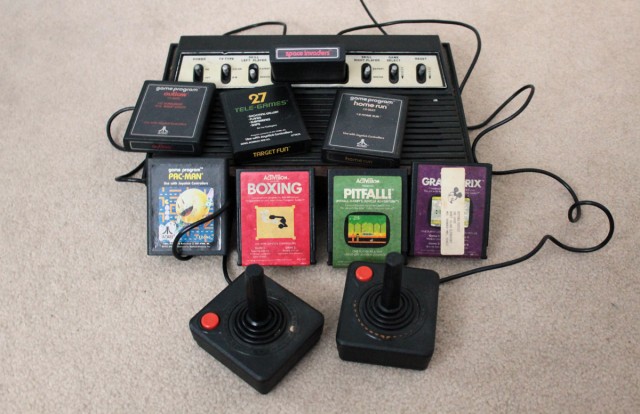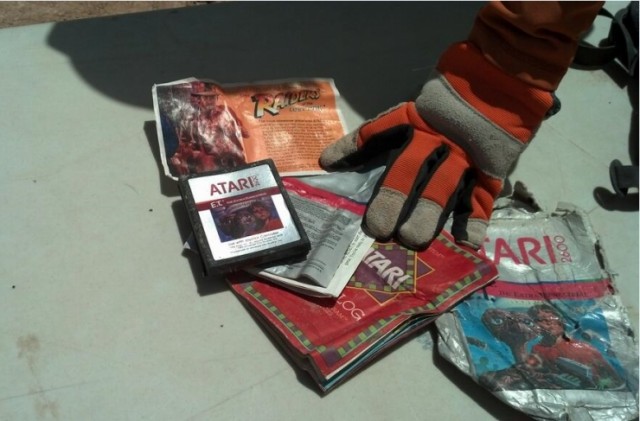- Home
- >
- Preservation Archaeology Blog
- >
- Atari Archaeology and Other Garbage
If you’ve been following the news over the last couple of weeks, you may have seen a story or two about a documentary film crew and a team of archaeologists heading to the New Mexico desert near Alamogordo to excavate the remains of the legendary Atari graveyard within the town landfill. I don’t remember the first time I heard about the Atari dump, but I do remember rumors of its existence spreading through playground gossip in the 1980s when I was a kid. The story I’d always heard was that the Atari 2600 game created to accompany the release of the film E.T. The Extra Terrestrial was so bad (often called the worst game of all time) and sold so poorly that Atari decided to bury their mistake in a landfill, so that it would never again see the light of day. The E.T. game isn’t exactly hard to come by these days, even given how many unsold copies there were, but it is terrible. I’ve played it. It’s not the worst game ever, in my opinion, but it is pretty bad.

The idea of Atari dumping unsold and poorly received games has been seen as a tale illustrative of industrial overreach and as a potent symbol of an industry-wide recession known as the North American video game crash of 1983. Revenues from home video games dropped from $3.2 billion in 1983 to about $100 million in 1985, hence the “crash.” Although there were actually contemporary reports of Atari burying something in New Mexico in the early 1980s , it was never quite clear to most exactly what was out there. Some of the most extreme accounts I’d heard suggested that the majority of the landfill was actually made up of the 3.5 million unsold copies of the E.T. cartridges. Adding to the speculation, various people involved with Atari in the 1980s—including the creator of the E.T. game, Howard Scott Warshaw—have said publicly that they doubted the dump ever took place. All of this fueled speculation, and the story, often called an urban legend, took on a sort of mythic status to those of us who love the nerdier things in life. There is even a fictional movie in production centered on the Atari dump.
Excitingly—to me at least—some of the questions revolving around this story have been addressed through recent archaeological excavations at the landfill site. A team of archaeologists including Andrew Reinhard, self-described punk archaeologist, began excavations at the site on April 26, 2014 and very quickly began recovering amazingly preserved cartridges, boxes, game manuals and other hardware from E.T. and other Atari games. Although it is still difficult to estimate the extent of the Atari dump, I think we can put a check mark in the “confirmed” box on this urban legend. The coverage of the recent excavations certainly demonstrates the fascination many members of the public felt for this story ,with articles appearing in countless tech and video game blogs. It was even picked up by news organizations across the world, and The New Yorker.

Thinking about the Atari dump and the story it helps tell about the early video game industry in North America also got me thinking about the archaeology of the future. What things are we leaving behind now that will reveal something about our lives to archaeologists 50, 100, 200 or even 500 years in the future? We’re certainly in an age of disposable material culture, so we’re leaving a lot of trash behind (and archaeologists love garbage), but what will preserve and what stories will it tell?
Some archaeologists began thinking along these lines many years ago. In 1973, Dr. William Rathje and archaeologists at the University of Arizona began the Tucson Garbage Project (TGP). The TGP focused on quantifying and comparing patterns of consumption among the contemporary residents of Archaeology Southwest’s own hometown of Tucson. The project involved collecting and inventorying peoples’ trash, as well as excavations in local landfills.

The idea behind the project was a simple one with which most archaeologists would probably agree: the things people use and discard can tell us things about their lives that historic accounts or even personal narratives often can’t or won’t (for example, the results of the TGP suggest that people substantially underreport their consumption of alcohol). Some of the objects recovered through the TGP were quite amazing, such as hot dogs thrown away years before that looked good as new and newspapers still readable after more than a decade (the newspapers provided a great way to date deposits, as well). The TGP and subsequent projects over the next 30 years factored into discussions on resource use and environmental protection policy, and they demonstrated one way that archaeology can contribute to contemporary social and environmental issues.
The Atari dump, and the recent fascination with it, also demonstrates to me how archaeology, in its many forms, can add richness to stories about the past, even when many people who remember the event are still alive. I certainly look forward to reading the results of the project.